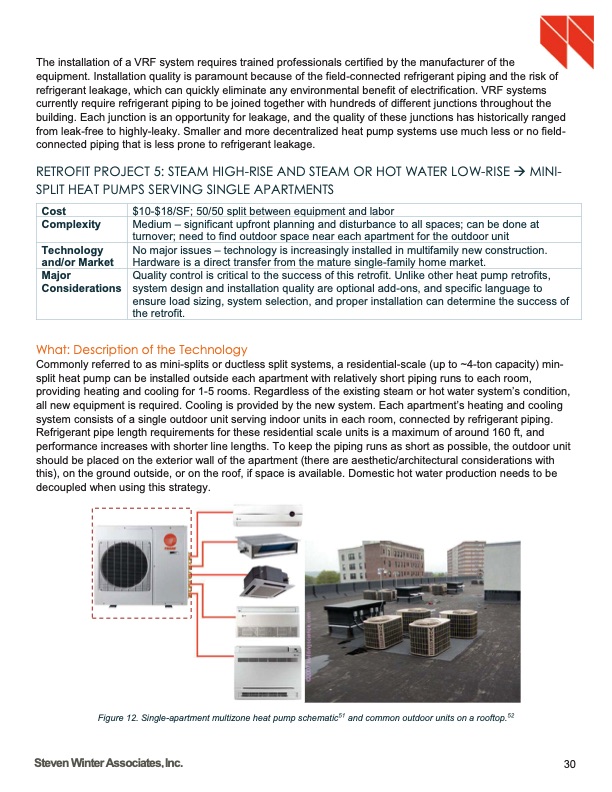
PDF Publication Title:
Text from PDF Page: 030
The installation of a VRF system requires trained professionals certified by the manufacturer of the equipment. Installation quality is paramount because of the field-connected refrigerant piping and the risk of refrigerant leakage, which can quickly eliminate any environmental benefit of electrification. VRF systems currently require refrigerant piping to be joined together with hundreds of different junctions throughout the building. Each junction is an opportunity for leakage, and the quality of these junctions has historically ranged from leak-free to highly-leaky. Smaller and more decentralized heat pump systems use much less or no field- connected piping that is less prone to refrigerant leakage. RETROFIT PROJECT 5: STEAM HIGH-RISE AND STEAM OR HOT WATER LOW-RISE�MINI- SPLIT HEAT PUMPS SERVING SINGLE APARTMENTS Cost Complexity Technology and/or Market $10-$18/SF; 50/50 split between equipment and labor Medium – significant upfront planning and disturbance to all spaces; can be done at turnover; need to find outdoor space near each apartment for the outdoor unit No major issues – technology is increasingly installed in multifamily new construction. Hardware is a direct transfer from the mature single-family home market. Major Considerations Quality control is critical to the success of this retrofit. Unlike other heat pump retrofits, system design and installation quality are optional add-ons, and specific language to ensure load sizing, system selection, and proper installation can determine the success of the retrofit. What: Description of the Technology Commonly referred to as mini-splits or ductless split systems, a residential-scale (up to ~4-ton capacity) min- split heat pump can be installed outside each apartment with relatively short piping runs to each room, providing heating and cooling for 1-5 rooms. Regardless of the existing steam or hot water system’s condition, all new equipment is required. Cooling is provided by the new system. Each apartment’s heating and cooling system consists of a single outdoor unit serving indoor units in each room, connected by refrigerant piping. Refrigerant pipe length requirements for these residential scale units is a maximum of around 160 ft, and performance increases with shorter line lengths. To keep the piping runs as short as possible, the outdoor unit should be placed on the exterior wall of the apartment (there are aesthetic/architectural considerations with this), on the ground outside, or on the roof, if space is available. Domestic hot water production needs to be decoupled when using this strategy. Figure 12. Single-apartment multizone heat pump schematic51 and common outdoor units on a rooftop.52 Steven Winter Associates,Inc. 30PDF Image | HEAT PUMP RETROFIT STRATEGIES FOR MULTIFAMILY BUILDINGS

PDF Search Title:
HEAT PUMP RETROFIT STRATEGIES FOR MULTIFAMILY BUILDINGSOriginal File Name Searched:
heat-pump-retrofit-strategies-report-05082019.pdfDIY PDF Search: Google It | Yahoo | Bing
CO2 Organic Rankine Cycle Experimenter Platform The supercritical CO2 phase change system is both a heat pump and organic rankine cycle which can be used for those purposes and as a supercritical extractor for advanced subcritical and supercritical extraction technology. Uses include producing nanoparticles, precious metal CO2 extraction, lithium battery recycling, and other applications... More Info
Heat Pumps CO2 ORC Heat Pump System Platform More Info
| CONTACT TEL: 608-238-6001 Email: greg@infinityturbine.com | RSS | AMP |